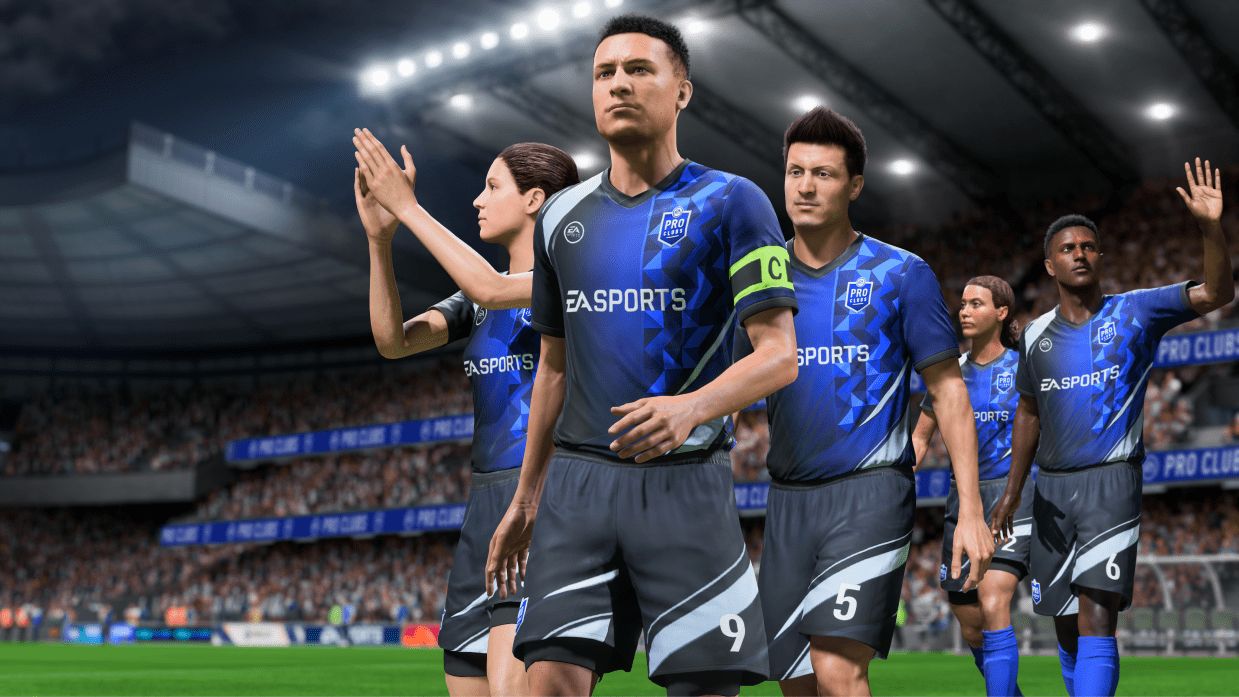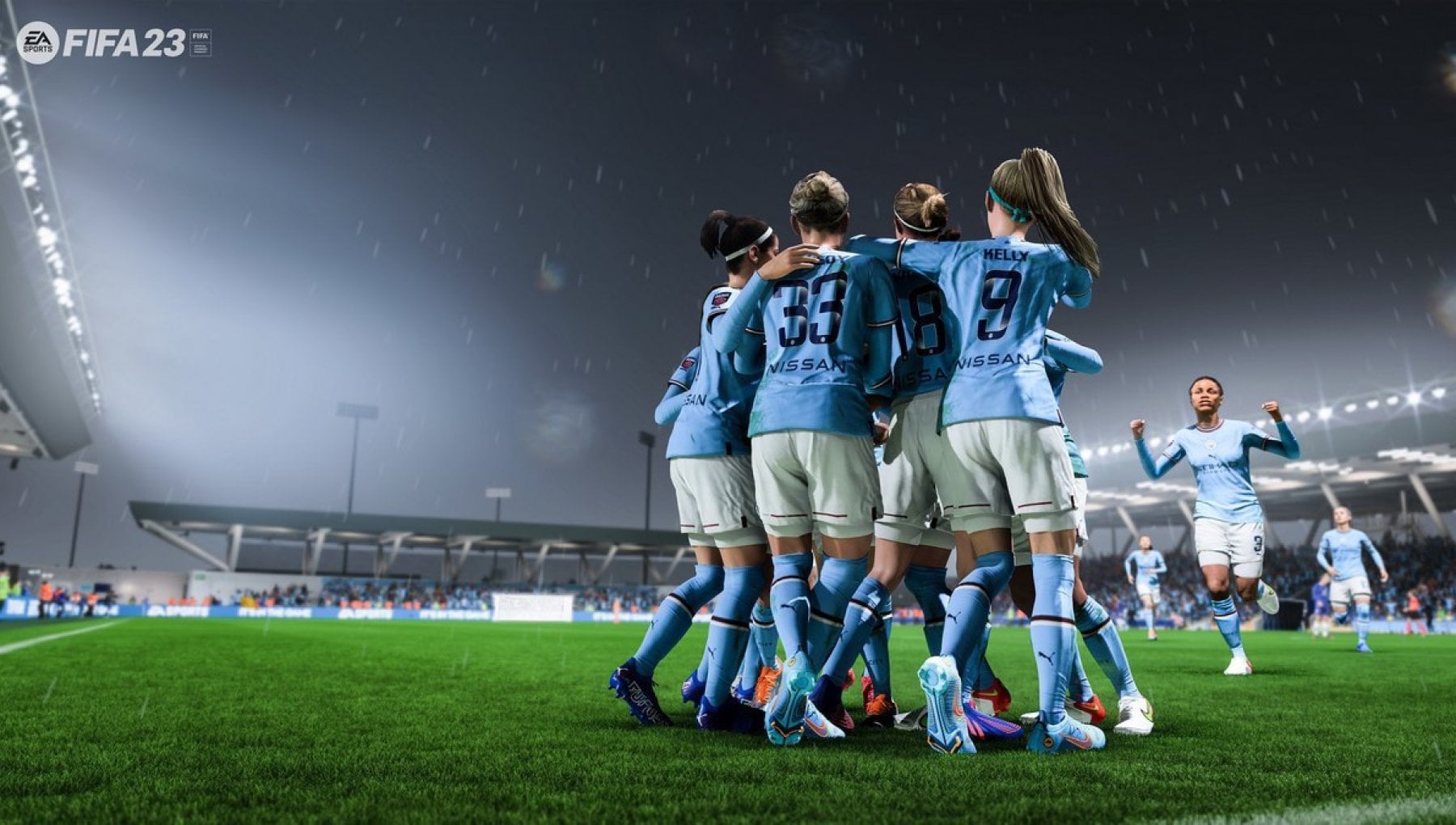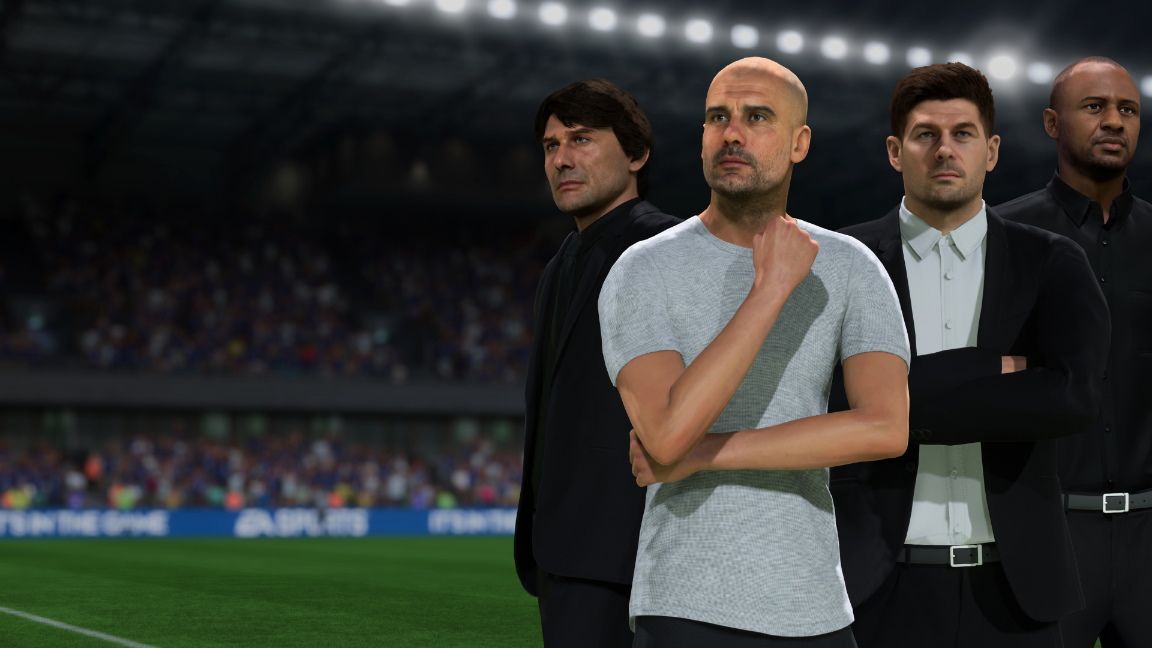
Will EA’s final game go out with a bang or a whimper? GameCentral gives its initial verdict on the last ever FIFA game from EA Sports.
The first FIFA game was released in 1993 for the Mega Drive, way back when the Premier League was a mere infant. 30 years later, the partnership between EA and FIFA is drawing to a close and any future FIFA-adjacent games will take a very different shape. In terms of EA’s future, it’s working on for next year and in light of this final entry it seems it may be saving its best tricks for its own new IP.
EA announced many changes to this year’s instalment of FIFA and has delivered exactly what was promised, but nothing in excess of that. The end result feels limiting and a disappointment, mostly because the same frustrations that have always existed in the franchise are still as strikingly annoying as they’ve always been.
Following our , we’ve now racked up over 20 hours with the game and are ready to give it a full review. Although, as always with FIFA, there are likely to be major changes in the months ahead, as new updates are released – although perhaps not necessarily as many as usual, given the changes coming next year.
We initially spent some frustrating hours managing a League Two team, which was where our first encounter with a lot of the new mechanics took place. The new sprint feature, AcceleRATE, gives a more believable adjustment to sprinting and pace. Players are sorted into one of three archetypes: explosive, lengthy, or controlled.
Explosive players are quick off the mark and can gain pace almost immediately, whereas lengthy players take time to accelerate but reach impressive top speeds. Controlled players are a healthy balance between the two.
It goes without saying that pace is a crucial statistic in FIFA gameplay, especially in FIFA Ultimate Team, where it can be the deciding factor as to whether to keep hold of a new player or not. Now, EA and FIFA have looked more carefully at real-world football and how different players adjust their pace.
Taking note of this new mechanic in games, it’s definitely brought an advantage in terms of variety of play. Each player now feels really different to control, as well as more dynamic. Utilising a wide open space with a player that falls into the lengthy archetype for pace can change the game, whereas getting away from a dangerous situation with an explosive player can be the deciding factor as to whether a goal is conceded or not.
Pacing has been a widely discussed problem with FIFA for some time now, and there’s definitely still some fine-tuning to be done with the AcceleRATE feature. For example, the majority of players fall into the controlled archetype, which doesn’t feel very different to previous games.
With future updates EA should consider recategorising some players, so that differences in pace and adjustment can be felt more dramatically on the field. The archetypes are currently distributed based on players’ height, agility, and strength attributes but this could rule out some players with fantastic real-world pace based on in-game statistics that don’t accurately reflect their true ability.
As an example, let’s take a look at cover star Kylian Mbappé. At 6 feet tall, he’s automatically excluded from the explosive archetype. As a controlled player, he should still be able to get away from players over time, but that doesn’t capture his true play style. Assigning archetypes manually, based on how they play and perform in real life, would have made much better use of an otherwise welcome new feature – at least for top players. As it is, it ends up feeling like big acquisitions such as Mbappé are less impactful than they should or could be.
Another mechanic that’s had an overhaul is set pieces. These are looked at with every new FIFA and, unsurprisingly, there’s always a section of the fanbase that’s never happy. This time around, it seems EA has struck gold with a genuinely fantastic new system, in one of the biggest revamps the series has seen for some time.
Free kicks look drastically different from FIFA 22, with the circular reticule being canned in favour of a much more intuitive trajectory line, which allows you to visualise the exact direction the ball will travel over the first few yards. Secondly, you can better judge where the player will strike the ball and apply spin to change the shot type. Aiming towards the right of the ball sees an effective curled shot over the wall, whereas nearer the top allows you to sneak one underneath it.
Speaking of the wall, it’s now possible to lay a defender behind it, as is often seen in real life games these days, as a ‘draft excluder’, to prevent those shots sneaking underneath when defending.
Alongside this, a feature more designed for newcomers to the series, but which is still useful for veterans, is a text box that displays exactly which type of shot is currently lined up, alongside a brand new display that shows the statistics of the selected shot taker. This makes it much easier to get the exact shot you want and already it seems many more set pieces are leading to successful goals than they were this time last year.

Corner kicks work in a similar manner, with the exception of the end destination. Working the ball into the box requires different tactics than aiming directly for the goal, but the mechanics aren’t too different. Line up the shot with the left stick to guide the trajectory line, before adding spin by using the right stick. Getting under the ball to send it to the back post or drawing the goalkeeper out of position are both viable options that seem to go as planned the majority of the time.
Penalties are something you don’t see much of in the early game, but a time will come when that dreaded moment rolls around. Penalties in FIFA have always been somewhat of an anomaly; often it’s not clear whether they’re anywhere near the target, but that has changed with FIFA 23. They now work on a timing system, which is indicated by an expanding and contracting composure ring around the ball.
A player’s composure statistic directly contributes to how effective they will be at taking the penalty, as the composure circle changes size. Interestingly, a penalty awarded in the 90th minute, which is needed in order to win the game, will see the composure circle moving much faster than it would in the first five minutes.
Hitting ‘shoot’ when the circle is at its smallest is the most effective way to ensure the highest accuracy possible, but mistiming will see the shot soaring over the top bar. Pressing shoot begins the runup, which then gives players a few seconds to perfect their aim before the strike hits.
Another shining new addition is the power shot. EA wanted to introduce more skill to shooting, so upon creating enough space for yourself, and taking aim, you can make some impressive shots that have much more power and accuracy but suffer from a longer animation which invites risk. Holding both bumpers on the DualSense controller, whilst pressing shoot, will start the longer animation, whilst the player directs the shot with no assistance. It does feel more rewarding when landing a goal like this, but it does take some getting used to, as the button input is the same as the low driven shot command from previous FIFA games.
This mechanic can be applied to most shot types, too. Headers, low shots and huge, soaring shots from a mile off all benefit, or indeed suffer, from the new power shot feature.
In terms of defenders, they now have the option to perform on-demand aggressive slide tackles, whilst those with better statistics can do backheel tackles. Players can also pass with parts of the body they were unable to in previous games, such as the back or bum. Left-footed players also finally execute skill moves with their left foot, which is an inclusive and nice touch.
Ultimate Team has had a huge chemistry overhaul. Players will now receive chemistry from their club-mates and national team members regardless of where they are on the pitch. This is a stark difference from previous games as now, for example, Erling Haaland, who plays forward for Manchester City, and Ederson, who plays in goal, can link together due to their club, whereas previously only the two centre-back players could link to a goalkeeper.
This reduces the need for microtransactions and helps achieve faster progress. Any improvement to a game that reduces the need for microtransactions is a good one, and this feels less pay to win than it did previously.
Also new are Ultimate Team moments, which are similar to side missions. A single-player experience contributes to obtaining stars, which can be exchanged for player packs. Moments put the player in a single-person scenario in order to recreate iconic football industry moments. As an example, Mbappé’s moment starts with him being noticed for his speed and excellent dribbling skills by AS Monaco. You then have to complete a mission to shake off an opponent before scoring goals within an allotted amount of time.
However, Moments can only be experienced if that player is on your team. In stark contrast to the previous improvement on minimising the need for microtransactions, this actually increases them and is a disappointment if you’ve not yet obtained your favourite player, because you won’t get to relive those iconic events in-game without them.
HyperMotion2 is the biggest new feature for FIFA 23 and there’s plenty to talk about with it. The feature is only available for next gen consoles, as well as Google’s Stadia and PC, and uses the data from matches that have had full motion capture, as well as training sessions with professional teams, with the end goal of having more realistic and varied animations.
The end result is exactly what it says on the tin. It’s more intricate, and gameplay feels more fluid. The players, pitch, and crowd all look great and the interactions with the ball are more natural. New dribbling animations add believability and variety. In terms of positives, the latter is the most striking one, providing the most visual adjustments to a FIFA game in recent history.

Customisation in career mode is equally varied and the additional ability to be able to play the role of real-world managers such as Jurgen Klopp, Carlo Ancelotti, and their counterparts is a welcome extra. The outfit adjustments, as well as club personalisation, feels more immersive and as if you have a say in the club right from the off. Having said that, there were certain moments and outfit choices that saw our manager’s feet disappear entirely, as well as other visual bugs.
Speaking of visual errors, there are often moments in cut scenes where players or items will clip through one another, and collisions seem to be going unnoticed by the game, as if they never happened. Seeing a player’s arm soar through the opposition’s leg with no reaction really drags you out of the immersion for a moment.
Buying a top player for the club introduces a cut scene showing the deal itself, the medical test, and the first address when the player arrives at the club. It adds more personality to the game. Unfortunately, the interactions are limited and the dialogue, which so easily could have been added in, is missing in a lot of scenarios. Negotiating for players isn’t so much a negotiation, but in most situations more a point-blank refusal to engage from the other club. Why bring me into a room to discuss the fee for a player only to refuse my first offer and leave?
EA has also introduced player personalities, which can be upgraded. The three personality archetypes are maverick, virtuoso, and heartbeat. Each has its own advantages and certain statistics are increased as a result of those. For example, maverick personalities are ambitious and therefore statistics are increased relating to shooting.
The personalities can also be improved through matches or shopping and investing. Buying a new car will increase maverick personality points and spending money can be obtained through investment or salary in order to achieve this. This adds a depth to the game that has previously been missing, with more possibilities outside of actual match play to aim towards and focus on.
The new career mode features add a nice sparkle but, unsurprisingly, do nothing to drastically change the feel of the mode or set it apart from previous FIFA experiences. If you’ve got FIFA 22, this alone probably isn’t worth the upgrade.
Volta mode adds a battle pass-esque track to a more arcade feeling experience, which is the only adjustment from last year’s game. There’s no premium version, so this isn’t a cash grab attempt by EA, and various rewards, from coins to cosmetics, can be obtained. The addition of rewards is an incentive to actually play the Volta mode, as previously there was different gameplay but no real reason to make the switch.
Having said that, Volta does introduce a grind. The street football style mode has increased the maximum level from 25 to 100, but the second reward only comes at level 35. It feels like a long journey for little payoff, and although the mode is fun we’ve not progressed beyond level 35 because the reward balance is just not worth it.
The first-time inclusion of women’s football has, let’s face it, taken far too long to come to fruition but now that it is here, it’s very welcome. The women’s team has the same attention to detail as the men’s, but with the unfortunate omission of the women’s World Cup.
That’s a long list of mostly positive changes but the truth is none of them really make any significant difference to the core experience, especially not when far more fundamental problems remain. Constantly watching defenders launch themselves to the back-left corner of the box, rendering any possibility of a positive offside decision, is infuriating.
It’s bewildering that a company can get so many things right but the important decisions – the improvements that are necessary to a football game – are lacking. Players should be making decisions that reflect accurately on real life play style, or at the very least to a standard considered for professional football. These aren’t even Sunday league level half of the time.
Pacing, whilst it has been overhauled and improved, is still a massive source of frustration. Having the turning circle of a small tank when the player you’re supposed to be controlling is a 5 foot 6 whippet is ridiculous and the anger at these two small problems consistently jeopardises the result of a game and your ability to have fun with it. These issues should have been addressed and adjusted about seven games ago and yet who would place bets that they’re not still going to be front and centre in EA Sports FC?
Cross-play, which was heavily advertised as a game-selling feature this time around, is mostly unavailable at launch for most of the game modes. Although it’s notable that EA made sure it works within the Ultimate Team mode, which is a huge statement about their attitude towards game modes that don’t include in-game microtransactions.
Ultimate Team has always been a massive cash grab, but the other modes deserve the attention and time put towards them, to make them cross-play compatible. The development team did put out a at the beginning of their deep-dive into the feature, acknowledging that this is disappointing, but it’s not hard to imagine why it wasn’t made a priority.
A lot of the rebalancing, new mechanics, and improvements feel like they should just have been DLC for FIFA 22, which you could argue is par for the course with any yearly sequel. The welcome additions of women’s football and HyperMotion2 technology are as EA promised them to be, but the pitfalls of the game remain disappointingly familiar.
FIFA 23 review summary
In Short: A disappointing final whistle from EA as the new mechanics and fine-tuning create little in the way of major change, for a series that has long been in need of a major revamp.
Pros: Women’s football being added is an essential move, and the HyperMotion2 technology has its moments where it really shines. Customisation is better than ever and set pieces are also improved.
Cons: Everything feels like just another FIFA game. The price point, especially on next gen, is insulting given the lack of significant changes.
Score: 6/10
Formats: PlayStation 5 (reviewed), Xbox One, PlayStation 4, Nintendo Switch, Xbox Series X/S, PC, and Stadia
Price: £69.99 (£59.99 on last gen)
Publisher: EA Sports
Developer: EA Vancouver and EA Romania
Release Date: 30th September 2022
Age Rating: 3
Email [email protected], leave a comment below, and .
Follow Metro Gaming on and email us at [email protected]
To submit Inbox letters and Reader’s Features more easily, without the need to send an email, just use our .
For more stories like this, .




















